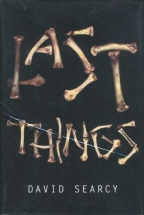Last Things
David Searcy
Viking / Penguin
US Hardcover First
ISBN 0-670-03132-1
Publication Date: 10-10-2002
278 Pages; $24.95
Date Reviewed: 10-15-02
Reviewed by Rick Kleffel © 2002

REFERENCES
COLUMNS
|
|
|
Last ThingsDavid SearcyViking / PenguinUS Hardcover FirstISBN 0-670-03132-1Publication Date: 10-10-2002278 Pages; $24.95Date Reviewed: 10-15-02Reviewed by Rick Kleffel © 2002 |
|
|
REFERENCES |
COLUMNS |
Some things can never be known, never be encapsulated in summary. In 'Last Things', David Searcy spends a lot of time and language trying to speak to, around and about things that cannot be known. By reading the omens we can fashion a story that fits, but it might be nothing more than a convenient overlay for the events that transpire. This is a novel that one reads but cannot easily describe afterwards. You can't say what happened -- only that something happened to you, the reader. Time was displaced, language was dispensed. 'Last Things' attempts to reach into a place of pure mystery, where knowledge dissolves like the fog at dawn. More often than not it gets there in a fashion that some readers will find infuriating, some invigorating. Searcy is not afraid of a three page paragraph, but there's good reason to think that readers will be. 'Last Things' sports an intriguing premise for a thriller, then delivers thrills that are purely cerebral and linguistic. It revels in what it doesn't show you.
'Last Things' begins in the Texas town of Gilmer when an unnamed city-dweller tooling through the landscape with her husband sees something that might have been a scarecrow. Luther Hazlitt finds it. Luther is a local nothing, supported by the good will of the landscape and tolerant landlord who allows Luther to live in a run-down trailer on the edge of his property. He and his friend Agnes Peeler, both clearly over-the-hill, have a fascinating bantering relationship that pulls the reader along. Their conversations are like the chats characters from a Flannery O'Connor story might have outside the bounds of O'Connor' tale. The scarecrow is strangely ominous, created artistically from the bones of small animals to look like angels. Soon other scarecrows start appearing.
Searcy has quite a bit of plot to unfold in 'Last Things', but readers will search in vain for anything resembling straightforward exposition. Instead, expect, meandering, wandering considerations of white skies, blank fields and minds slowly emptying themselves under the hot Texan sun. Expect also more than a bit of humor as Luther struggles with what come to resemble feelings for Agnes, his nasty dog, a chow named Yurang and a box full of puppies. To his credit, though he might write a three-page paragraph, Searcy also writes in chapters that are short. He parcels out the story in dollops of unique prose that linger long after the reader has consumed the last word. Somehow, Searcy pulls off the tremendous feat of unifying all these disparate elements in a narrative that either haunting or impenetrable.
The impenetrability turns out to be Searcy's biggest weapon in this assault on the reader's consciousness. It's well known that terror, the grown up version of horror, works a lot better when the reader sees less. Searcy manages to suggest intense dangerous beings just outside the reader's ken. It's a high-wire act and his balance is astonishing. He also covers a wide range of subjects and perception in what might appear to be just another intense Southern Gothic. The pixilated world of digitized information gets a fantastic low-tech treatment in 'Last Things'. Stonehenge crops up in the early morning sunlight. Events documented by Charles Fort and Ivan T. Sanderson, from faerie encounters to will o' the wisp are sewn seamlessly into the narrative.
Searcy is a very unusual writer. He clearly wants to be considered a horror writer, but the fiction he writes bears little semblance to what is typically thought of as horror these days. He re-invents the genre in a particularly personal fashion. His idiosyncratic prose frequently turns back to regard itself. He studiously avoids of any of the page-turning elements of thriller fiction. But Searcy unquestionably delivers genuine chills and the unfortunate knowledge that comprise the feel of the best horror fiction. He also provides moments of elegiac beauty, slow spiraling pans across a tormented landscape either mental or actual. There's little difference between the two in 'Last Things'. Searcy's horror stories are tales told by an individual, full of sound and fury. What they signify is beyond words, captured only by readers who finish the novels. It's an experience unlike any other.